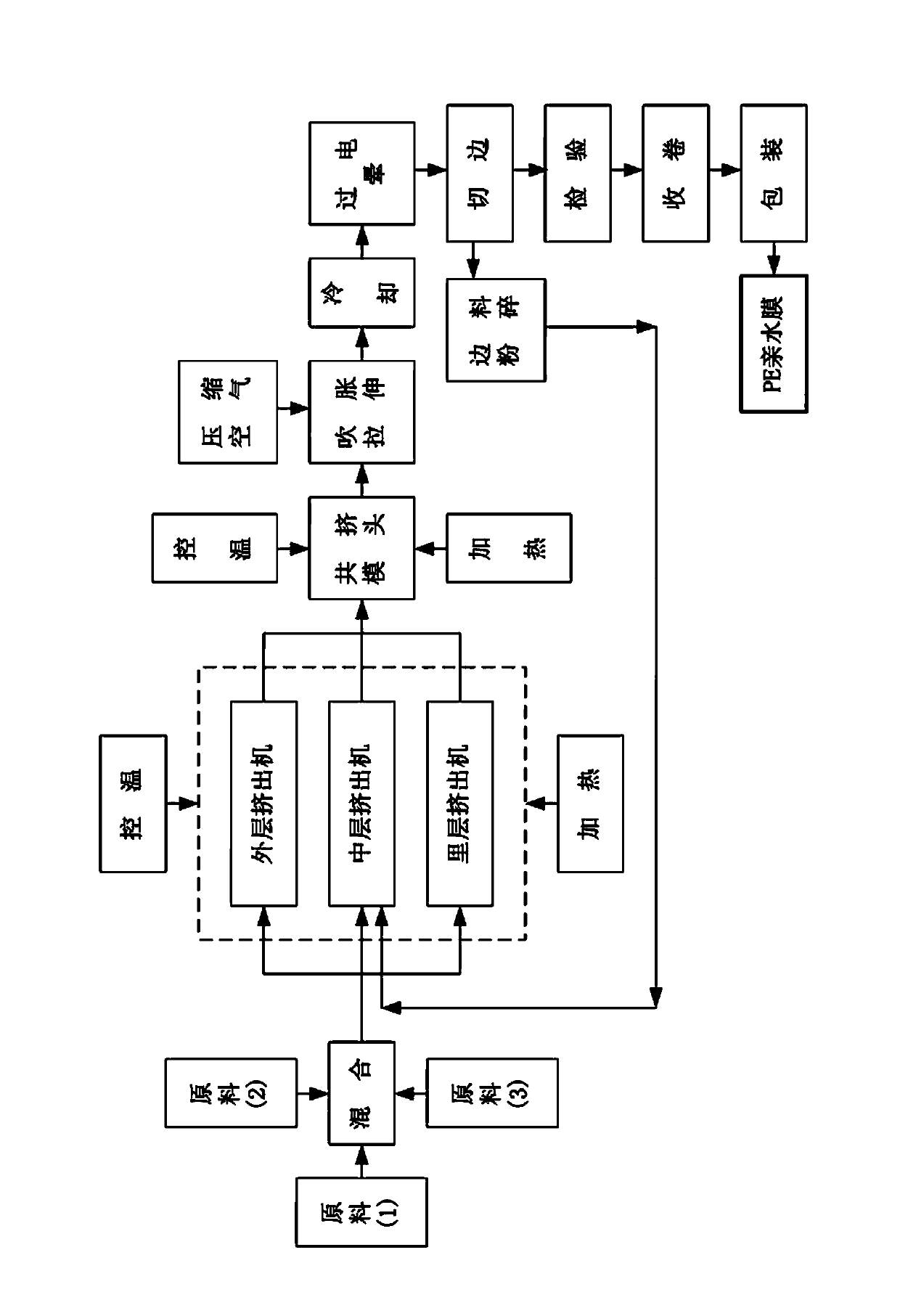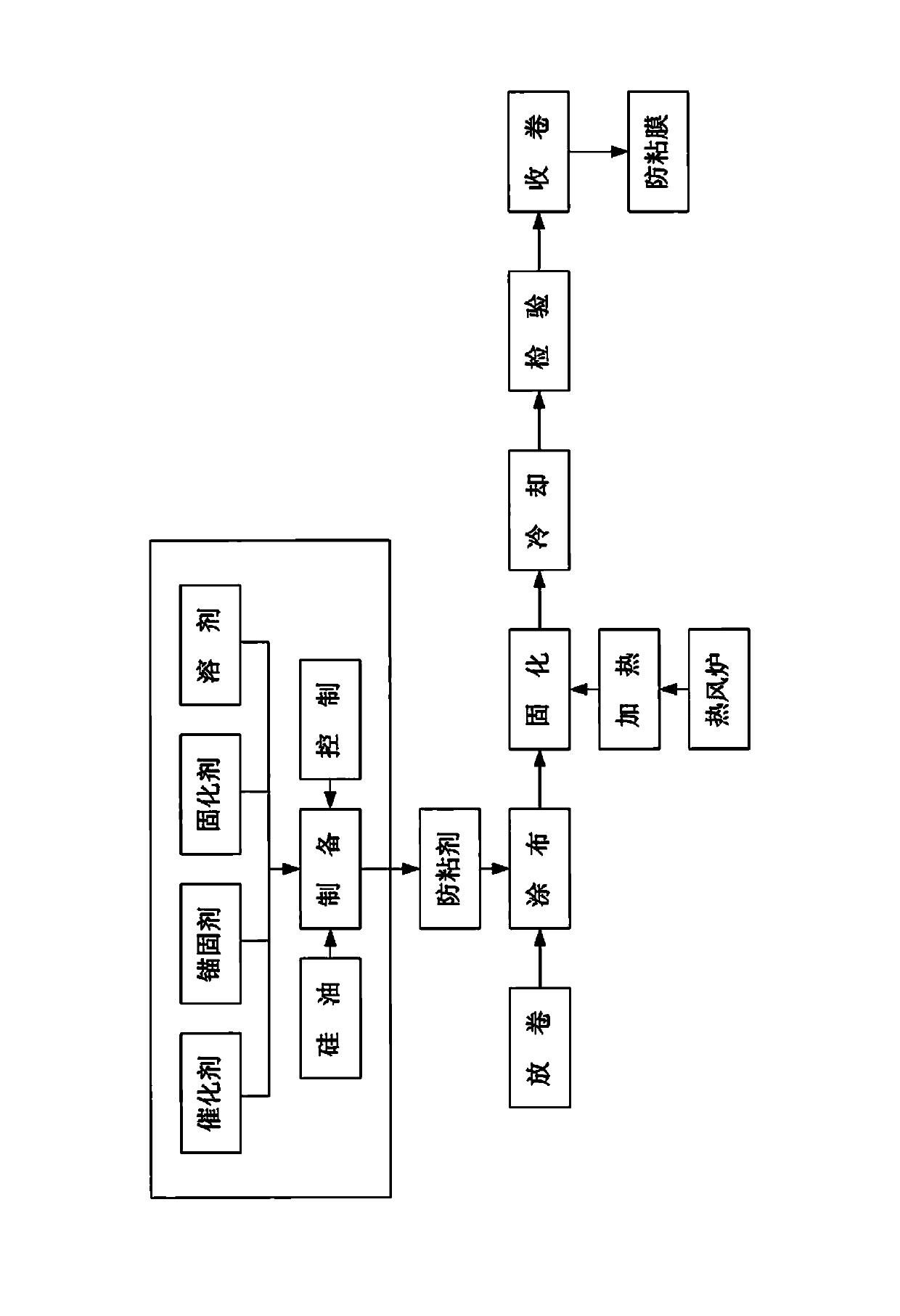Hydrophilic anti-adherent film and preparation method
An anti-film, hydrophilic technology, applied in the field of hydrophilic anti-film and its preparation, can solve the problems of film shrinkage or silicon transfer, production failure, poor temperature resistance, etc., to reduce labor costs, avoid silicon transfer, Good infiltration effect
- Summary
- Abstract
- Description
- Claims
- Application Information
AI Technical Summary
Problems solved by technology
Method used
Image
Examples
Embodiment 1
[0093] Take the following raw material ratio to prepare hydrophilic anti-adhesive film 1# through the above preparation method:
[0094] Anti-adhesive layer: 100.0 parts of high-density polyethylene,
[0095] Middle layer: high-density polyethylene 60.0 parts
[0096] Low-density polyethylene 15.0 parts
[0097] 15.0 parts of 800-1200 mesh heavy calcium carbonate powder
[0098] 10.0 copies of trimmed recycled materials
[0099] Hydrophilic layer: 60.0 parts of high-density polyethylene
[0100] 15 parts polyvinyl alcohol
[0101] Low-density polyethylene 20.0 parts
[0102] Masterbatch (white) 5.0 parts
[0103] Anti-sticking agent: 12.0 parts of vinyl silicone oil,
[0104] 3.5 parts of chloroplatinic acid
[0105] 1.3 parts of hydrogen-containing silicone resin,
[0106] 0.7 parts of styrene-butadiene resin
Embodiment 2
[0109] Take the following raw material ratio to prepare hydrophilic anti-adhesive film 2# through the above preparation method:
[0110] Anti-adhesive layer: 100.0 parts of high-density polyethylene,
[0111] Middle layer: 50.0 parts of high-density polyethylene
[0112] Low-density polyethylene 10.0 parts
[0113] 10.0 parts of 800-1200 mesh heavy calcium carbonate powder
[0114]30.0 copies of trimmed recycled materials
[0115] Hydrophilic layer: 80.0 parts of high-density polyethylene
[0116] 5.0 parts of polyvinyl alcohol
[0117] Low-density polyethylene 5.0 parts
[0118] Masterbatch (white) 10.0 parts
[0119] Anti-sticking agent: vinyl silicone oil 18.0 parts,
[0120] 7.5 parts of chloroplatinic acid
[0121] Hydrogen-containing silicone resin 2.0 parts,
[0122] 1.2 parts of styrene-butadiene resin
Embodiment 3
[0125] Take the following raw material ratio to prepare hydrophilic anti-adhesive film 3# through the above preparation method:
[0126] Anti-adhesive layer: Homopolypropylene 100.0 parts,
[0127] Middle layer: high-density polyethylene 60.0 parts
[0128] Low-density polyethylene 10.0 parts
[0129] 15.0 parts of 800-1200 mesh quartz powder
[0130] 15.0 copies of trimmed recycled materials
[0131] Hydrophilic layer: 60.0 parts of high-density polyethylene
[0132] Ethylene-vinyl acetate resin 20.0 parts
[0133] Low-density polyethylene 15.0 parts
[0134] Masterbatch (white) 5.0 parts
[0135] Anti-sticking agent: 15.0 parts of vinyl silicone oil,
[0136] Chloroplatinic acid 5.0 parts
[0137] 1.8 parts of hydrogen-containing silicone resin,
[0138] 0.9 parts of styrene-butadiene resin
[0139] 77.3 parts of 120# solvent gasoline.
PUM
| Property | Measurement | Unit |
|---|---|---|
| Granularity | aaaaa | aaaaa |
| Thickness | aaaaa | aaaaa |
Abstract
Description
Claims
Application Information
 Login to View More
Login to View More - R&D
- Intellectual Property
- Life Sciences
- Materials
- Tech Scout
- Unparalleled Data Quality
- Higher Quality Content
- 60% Fewer Hallucinations
Browse by: Latest US Patents, China's latest patents, Technical Efficacy Thesaurus, Application Domain, Technology Topic, Popular Technical Reports.
© 2025 PatSnap. All rights reserved.Legal|Privacy policy|Modern Slavery Act Transparency Statement|Sitemap|About US| Contact US: help@patsnap.com



